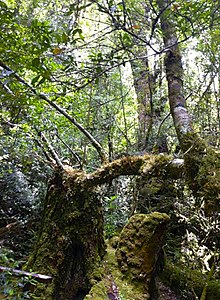| Anodopetalum | |
|---|---|

| |
| Displaying its 'horizontal' growth habit | |
| Conservation status | |
 Least Concern (IUCN 3.1) | |
| Scientific classification | |
| Kingdom: | Plantae |
| Clade: | Tracheophytes |
| Clade: | Angiosperms |
| Clade: | Eudicots |
| Clade: | Rosids |
| Order: | Oxalidales |
| Family: | Cunoniaceae |
| Genus: | Anodopetalum A.Cunn. ex Endl. |
| Species: | A. biglandulosum |
| Binomial name | |
| Anodopetalum biglandulosum (Hook.) Hook.f. | |
Anodopetalum biglandulosum is a Tasmanian endemic shrub or small tree species that is a common component of Tasmania's cool temperate rainforests. It is commonly known as horizontal because of its habit of growth. It is the sole species in the genus Anodopetalum.
Morphology
Growth form
Anodopetalum biglandulosum is commonly known as horizontal scrub due to the habit of its slender trunk (primary shoot) bending down horizontally under its own weight. This fallen stem sends vertical branches up its length (secondary shoots), which in turn bend down and branches arise (tertiary shoots), forming an impenetrable horizontal scrub. The creation of light gaps in the canopy changes light intensity, causing dormant buds at the branch nodes to overcome apical dominance and produce secondary and tertiary shoots. Vegetative reproduction is the main mode of regeneration in A. biglandulosum. The species is commonly less than 8m in height but can grow up to 12m tall in deep soiled, sheltered gullies.

Leaf morphology
The leaves are opposite and unifoliolate. The leaves are bright green, narrow elliptical to ovate in shape, (5-15mm wide) and (15-60mm long), end with a blunt point and have coarsely serrated margins.

Flower and fruit morphology
Anodopetalum is from Greek roots an 'not', odous 'tooth' and petalum 'petal', originating from the non-toothed nature of the Anodopetalum biglandulosum petals. The solitary or occasional inflorescence of two to three flowers, grow in the leaf axils and are between 4–8mm long. The four sepals are ovate in shape and are 4–6mm long. The four petals are lanceolate in shape, green-yellow in colour and 2–3 mm long. Flowering occurs in November and December.
Anodopetalum biglandulosum fruit is fleshy, green and 13–14 mm long and 2–6 mm wide with a solitary seed.
Distribution
Anodopetalum biglandulosum is a Tasmanian endemic species that is a common component of Tasmanian cool temperate rainforests. Tasmanian rainforests are classified along a fertility gradient into three major types: callidendrous, thamnic and implicate rainforests. Callidendrous rainforests are tall, park-like forests with few shrubs in the understory, located on high fertility soils. Thamnic rainforests are well-formed trees, medium in height, with a distinct shrub layer on intermediate fertility soils. Implicate rainforests are low, tangled forests with uneven canopies on infertile soils. Anodopetalum biglandulosum is typically an understory species in thamnic rainforests, as well as a canopy species in implicate rainforests. This species is present below 1100m altitude in high rainfall areas (in excess of 1750mm) and on poorly drained acid soils in Western and Southern Tasmania. In these locations, A. biglandulosum forms a tangle of stems producing its characteristic 'horizontal' scrub growth.
Growth variation
Anodopetalum biglandulosum has a flexible growth form. There are four main classifications of growth form: single stemmed and suckering shrub, multi-stemmed coppice, tangled shrub and monopodial tree. Variation in growth form is due to forest type, community structure and the degree of disturbance.
Response to disturbance
Anodopetalum biglandulosum has the ability to regenerate after low intensity fires. After fire disturbance, vegetative regeneration occurs by sprouting from protected buds at the base of stems. Vegetative reproduction after fire disturbances allows A. biglandulosum to return to pre-fire density by reaching sexual maturity and forming a closed canopy. This major form of regeneration is advantageous over seed reproduction, as A. biglandulosum seedlings are intolerant of shade and susceptible to grazing.
References
- ^ IUCN SSC Global Tree Specialist Group.; Botanic Gardens Conservation International (BGCI). (2021). "Anodopetalum biglandulosum". IUCN Red List of Threatened Species. 2021: e.T200350788A200350790. doi:10.2305/IUCN.UK.2021-2.RLTS.T200350788A200350790.en. Retrieved 1 October 2022.
- ^ Barnes, R.W.; Rozefelds, A.C. (2000). "Comparative morphology of Anodopetalum (Cunoniaceae)". Australian Systematic Botany. 13 (2): 267–282. doi:10.1071/SB99006.
- "Anodopetalum biglandulosum (A.Cunn. ex Hook.) Hook.f." The Atlas of Living Australia. Retrieved 1 October 2022.
- "CUNONIACEAE Anodopetalum biglandulosum". UTAS Species Information. University of Tasmania. Retrieved 1 October 2022.
- ^ Cameron, M. (2000). A Guide To Flowers & Plants Of Tasmania (3rd ed.). Sydney: Reed New Holland.
- ^ Reid, J.B.; Hill, R.S.; Brown, M.J.; Hovenden, M.J. (1999). Vegetation of Tasmania (8th ed.). Hobart, Tasmania: Australian Biological Resources Study.
- Jarman, S.J.; Kantvilas, G.; Brown, M.J. (1991). Floristic and Ecological Studies in Tasmanian Rainforest (3rd ed.). Hobart, Tasmania: The Tasmanian component of the National Rainforest Conservation Program.
- ^ Barker, P.; Brown, M. (1994). "Anodopetalum biglandulosum: Growth form and abundance in Tasmanian rainforest". Australian Journal of Ecology. 4 (19): 435–443. Bibcode:1994AusEc..19..435B. doi:10.1111/j.1442-9993.1994.tb00509.x.
- ^ Barker, P. (1990). Tasmanian Rainforest Research: Stand Architecture of Anodopetalum biglandulosum. Hobart, Tasmania: The Tasmanian component of the National Rainforest Program. pp. 27–34.
| Taxon identifiers | |
|---|---|
| Anodopetalum | |
| Anodopetalum biglandulosum |
|